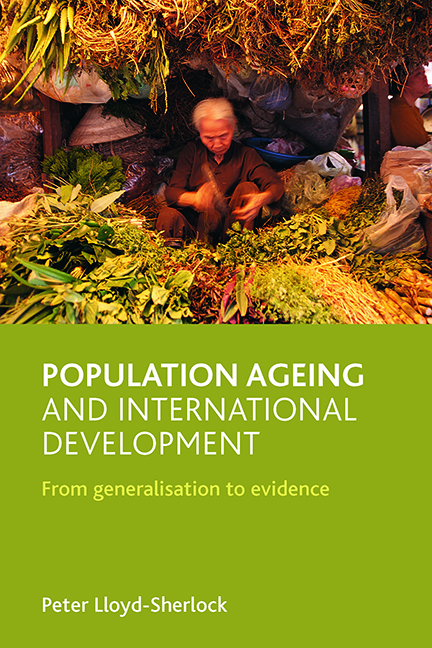Book contents
- Frontmatter
- Contents
- List of abbreviations
- Acknowledgements
- Notes on the author
- Introduction
- one International development and population ageing
- two Experiencing later life in contexts of development
- three Older people, pensions and development
- four Population ageing and health
- five Later life and social relations: family, migration and care
- six Ageing and development in South Africa
- seven Ageing and development in Argentina
- eight Ageing and development in India
- nine Conclusions and overview
- References
nine - Conclusions and overview
Published online by Cambridge University Press: 15 July 2022
- Frontmatter
- Contents
- List of abbreviations
- Acknowledgements
- Notes on the author
- Introduction
- one International development and population ageing
- two Experiencing later life in contexts of development
- three Older people, pensions and development
- four Population ageing and health
- five Later life and social relations: family, migration and care
- six Ageing and development in South Africa
- seven Ageing and development in Argentina
- eight Ageing and development in India
- nine Conclusions and overview
- References
Summary
This final chapter begins with some comparisons across the three country case studies. It then highlights some of the main themes to emerge from this book and identifies key priorities for policy makers.
Comparing the three country case studies
The central theme of this book is the danger of generalisation: be it about processes of development, patterns of population change or the lives of older people. The varied experiences of the three study countries highlight this point. Table 9.1 shows that each country experienced a unique trajectory of fertility transition and population ageing. In the case of Argentina, this had set in well before 1960, and as a result it already has a relatively aged population structure. In South Africa and India, fertility levels were still high in 1960, but fell sharply thereafter. By 2025, their fertility rates will have converged with Argentina’s, but they will still be some way behind in terms of population ageing.
These varied demographic profiles are rooted in socioeconomic differences across the study countries, but this relationship is complex. India was a much poorer country than Argentina in 1960 – their per capita GDPs were US$83 and US$524, respectively. This partly explains the slower pace of population change in India. Yet South Africa's national wealth in 1960 (US$422 per capita) was not far below Argentina’s. In this case, high levels of fertility reflected huge disparities in wealth and human development between different racial groups. This shows that it is important to go beyond national-level analysis to assess variations within countries. While race was a less significant issue in India and Argentina, there were important variations in patterns of development and population change across regions and between rural and urban areas.
The country studies also demonstrate the diversity of individual experiences of old age. This is particularly clear in the personal life histories included at the end of each case study chapter. Patterns and causes of diversity vary across countries. For example, it is unlikely that gender effects in Argentina will be identical to those in India. South Africa's generous social pension programme means that lifetime employment has less effect on personal income in old age there than in India or Argentina.
- Type
- Chapter
- Information
- Population Ageing and International DevelopmentFrom Generalisation to Evidence, pp. 231 - 236Publisher: Bristol University PressPrint publication year: 2010



